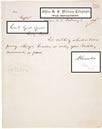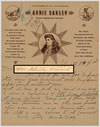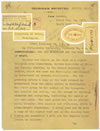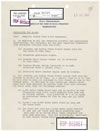
Identifying Important Government Documents
Historical U.S. government documents (federal, congressional, and presidential records) are documents generally created or received by the President and his staff, by Congress, by employees of Federal government agencies, and by the Federal courts in the course of their official duties.
Here are some tips for identifying historical U.S. government documents so you can avoid acquiring them:
- Obtain an explanation and written proof of the ownership history of the document(s), including the name, contact information, and dates of ownership for the document’s previous owners.
- Look for marks or stamps that indicate that the document was filed in a government office, such as federal letterheads, file code markings, captions, signature blocks on architectural drawings, or correspondence codes.
- Look for marks that appear to be erasures of file codes or address lines.
- Look for areas of the document that have been cut away or trimmed to remove file codes or ownership marks.
- Look for materials addressed to federal employees, agencies, Presidential staff, Congress, and courts (e.g., incoming Federal correspondence).
- Look for master or office copies of materials such as photographic negatives, signed linen architectural drawings, or office copies of outgoing correspondence.
Historical U.S. government documents include architectural drawings, certificates, charts, drawings, electronic historical documents, forms, legal documents, letters, maps, memos, motion picture films, photographs, plans, posters, and other documents created or acquired and kept by the President and his staff, Congress, and Federal governmental agency employees and contractors as part of their official Federal jobs. Most of the time, it is easy to identify a Federal record by determining if the historical document was kept and used in the White House or a Federal office.
Often, people suspect that documents are historical U.S. government documents simply because document(s) originated in the government. However, government agencies routinely create many documents that are sent to people outside government, such as signed photographs or letters containing answers to questions posed by the public. Usually, these outgoing items are not U.S. government records. Other documents have been maintained by the government because of their importance to history. See how governmental records have been managed since 1776.
If you would like to help NARA look for missing historical U.S. government documents, please contact the National Archives.




